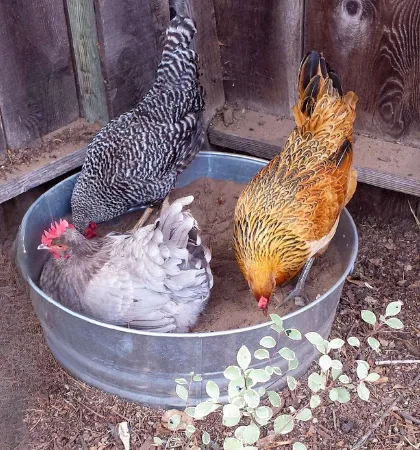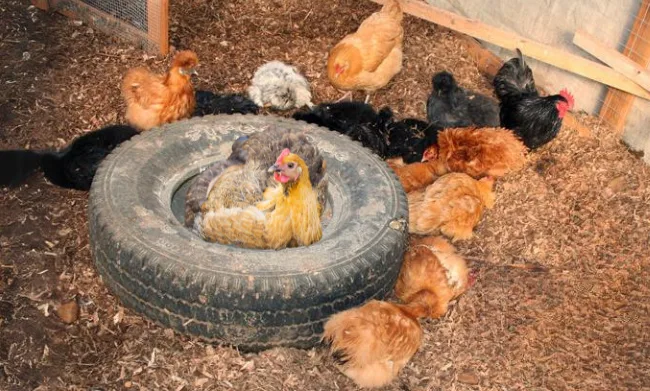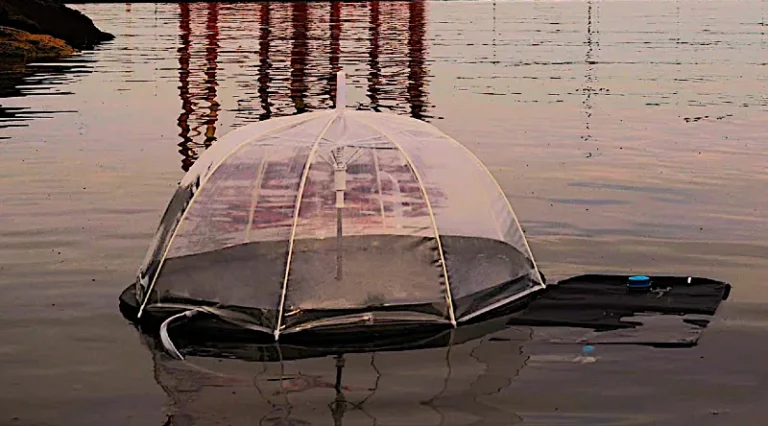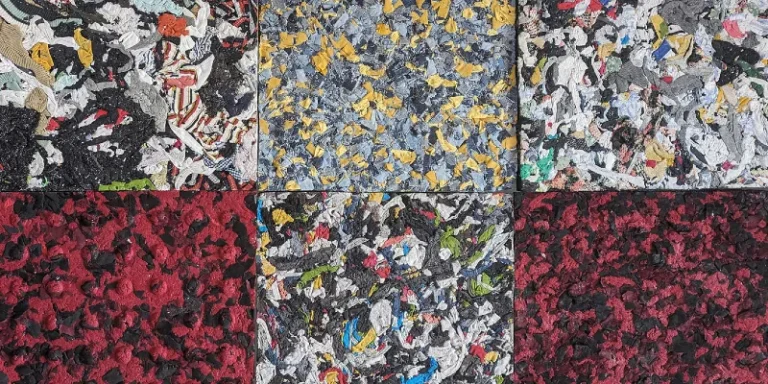Introduction to the World of Chicken Dust Baths
Every backyard chicken keeper knows the joy of watching their feathered friends take a plunge into a DIY chicken dust bath. These baths aren’t just a whimsical activity, but a fundamental aspect of poultry care, essential for maintaining health and hygiene amongst backyard chickens.
Chicken dust baths serve as a natural pest repellent, offering a simple yet effective method to keep mites, lice, and other external parasites at bay.
By understanding how to craft the ultimate dust bath, chicken owners can ensure their flock thrives, free from the discomfort of infestations and excess oil or unpleasant odor.
Key Takeaways:
- Essential care: Chicken dust baths are critical for poultry health and hygiene.
- DIY efficiency: Creating a personalized dust bath promotes flock well-being more effectively than store-bought alternatives.
- Ingredient benefits: Specific components like diatomaceous earth and peat moss are integral for a supreme dust bath mix.
The Basics of Creating a DIY Chicken Dust Bath
Many chicken keepers know the joys of creating their own dust bath area. A DIY approach is cost-effective and allows for customization to meet the specific needs of a backyard flock.
Crafting your perfect mix involves choosing from key ingredients like diatomaceous earth for pest control, peat moss for moisture balance, and perhaps a sprinkle of sulfur dust as a natural pest repellent (not too much).
You might repurpose an old kiddie pool or even an old apple crate as the dust bath container. Easily fill it with a measured blend of dry dirt, sand—preferably builder’s sand for its fine texture—and any other dust bath ingredients that cater to the health and happiness of your feathered friends. Meaning, you can customize and cater to your chickens! We have a few recipes below.
This level of personalization ensures every chicken, from the old veteran of the chicken run to the newly introduced baby chicks, gets to indulge in this essential, natural behavior. For chicken owners living within city limits or managing a larger flock, the DIY route offers a flexibility that store-bought options can’t match. And did I forget to mention that DIY is cheaper!

Key Components of a Supreme Dust Bath Mix
Putting together a supreme dust bath mix taps into the essence of poultry hygiene and only requires a few simple steps. We’re focusing on the heart of a backyard chicken’s well-being here.
- Builder’s sand, this is going to make up at least half of your chickens’ dust bath, if not more. This is the foundational ingredient.
- Diatomaceous earth, a powdery substance, is often the cornerstone ingredient, its sharp edges deter external parasites but don’t bother the chickens.
- Adding peat moss into the blend acts as the moisture control backbone, ensuring the mix remains dry and absorbent.
- Next up is sulfur dust for its potent defense mechanism against skin invaders. This creates a protective barrier without compromising the health of your feathered friends.

These key components, each selected with a specific purpose, work together to form a dust bath mix that champions the hygiene and contentment of every backyard flock.
Sand Is The Foundation of a Comfortable Chicken Dust Bath
At the heart of any successful DIY chicken dust bath lies its most fundamental ingredient: sand. Not just any sand, but builder’s sand because it has a fine texture and excellent drainage properties.
Don’t listen to anyone who tells you that builder’s sand doesn’t make a difference – it does, so use it. This sand acts as the base layer, inviting chickens to indulge in their natural dust-bathing rituals with ease. It’s the substrate that mimics their natural environment, providing the perfect granularity for effective preening and parasite removal.
Sand is indispensable, but not all sand is equal. You must steer clear of beach sand and heavy clay soil. Beach sand often contains salt and other minerals detrimental to chickens’ health, and heavy clay soil can harden, making it difficult for chickens to bathe properly.
Builder’s sand offers the perfect balance, ensuring your feathered friends can roll, scratch, and maintain their plumage naturally and gleefully (you own chickens, you know what I mean). Your DIY dust bath with builder’s sand will become a focal point of chicken wellness.
Understanding The Role of Diatomaceous Earth
Let’s discuss diatomaceous earth because it plays a crucial role in this process and one, we can’t overlook. This powdery substance has been recognized for its remarkable ability to repel pests naturally. Unlike harsh chemical treatments, food grade diatomaceous earth is safe for your chickens. No harsh chemicals or toxins, and yet it very effectively keeps away mites and lice without endangering your chicken’s health.
Diatomaceous earth is a powder made from very tiny, fossilized water plants called diatoms (sounds very science-y, but it’s completely natural). These plants have hard shells made of a substance called silica. When diatoms die, their shells pile up on the bottom of oceans or lakes and turn into a kind of rock. This rock is ground into a fine, white powder. This powder is safe for people and animals to eat, but it’s sharp at a microscopic level. In your hand, it feels like a soft fine powder, but microscopically, it looks jagged and dangerous.
So, when bugs with exoskeletons, like fleas and ants, crawl over it, it cuts them and dries them out, killing them. You can use diatomaceous earth in gardens, on pets, and even inside homes to control pests. It’s also used to filter water and can be found in a few products you already have in your house like toothpaste and skin care items because of its abrasive properties.
And now you know why a prime dust bath recipe for your chickens should include diatomaceous earth! Hence, diatomaceous earth has emerged as a key ingredient for any DIY chicken dust bath area, offering backyard chickens a chance to indulge in this natural behavior while safeguarding their skin and feathers against excess moisture and oil. Its addition enhances the efficiency of the bathing area, fulfilling one of the basic needs of happy chickens – a space where they can indulge in their traditional bath ritual without concerns of pest infestation.

Why Peat Moss is a Great Addition
Next up, we have the power of peat moss! Toss some peat moss into your chicken dust bath ingredients for its unique moisture absorption capabilities. Why do you want to absorb moisture? Peat moss keeps excess oil and moisture from building up on your chickens’ feathers. It acts almost like a leave-in power shampoo for your chicks.
In a mix teeming with fine sand and diatomaceous earth, peat moss also adds a softness that neither of the other ingredients can match, creating a spa-like environment for your backyard chickens.
During periods of heavy rain, when the ground turns too soggy for a dust bath’s natural creation, you’ll be glad you added peat moss! Not only does it cater to the basic needs for hygiene and the removal of external parasites, but peat moss also transforms the dirt bath into a more inviting spot. For chicken keepers within city limits or those managing free-range hens, adding peat moss in a kiddie pool or other suitable container makes for a cleaner, happier flock.
Nearly all successful chicken keepers use peat moss in their chicken dust bath mix for a reason – it crafts the perfect backyard oasis for their feathered friends.
The Surprising Benefits of Adding Sulfur Dust
Backyard chicken keepers have discovered a powerful ally in sulfur dust for maintaining the health of their chickens, and one that isn’t discussed that often. Sulfur dust, known for its natural pest-repelling properties, also provides a safe, effective means of warding off external parasites such as mites and lice. These pests cause significant discomfort and health issues in a backyard flock. Treatments can be pricey and time-consuming and, quite frankly, a bit traumatic to your chicks, so prevention is key for any diligent chicken owner.
Do I need sulfur dust if I already have diatomaceous earth and peat moss?
Yes! Simply put, a responsible chicken keeper can’t offer too much protection to the flock, regardless of its size. Whether you have a few chickens, a few dozen, or hundreds, the stronger your DIY dust bath is, the less you have to worry about when it comes to your chickens’ overall health and wellbeing.
So, you’ll want to add some sulfur dust into the dust bath mix. Your chickens get an extra protective barrier against unwanted pests, and you get extra peace of mind. It’s a win-win.
Sulfur dust achieves this without posing harm to the chickens, which is why it’s established itself as a crucial component of any DIY chicken dust bath area.
Selecting the Perfect Container for Your Dust Bath

Finding the right dust bath container is a key decision for chicken keepers, but don’t overcomplicate it! Your chickens don’t have an opinion on the latest Pinterest trends or unnecessarily complicated DIY projects on TikTok. Keep it simple and save yourself time and money!
Kiddie pools or old tires are economical and effective. Either option will serve wonderfully in a backyard chicken run. Your dust bath container should be at least 12 inches deep by 15 inches wide by 24 inches long. Your goal is to allow the birds to engage in this natural behavior, which naturally occurs in a random patch of dust on the ground – so, the bar is pretty low here. Kiddie pools, old tires, old fire pit, kids sandbox, unused raised garden bed… all viable options.
A larger flock will need a more spacious solution, like a big, galvanized tub. This ensures all the chickens have ample space for their social activity.
Consider the available area within your coop or run. The best uses of space contribute to happy chickens and a well-maintained bathing area. Whether you’re a first-time chicken owner or have been free ranging your flock for years, selecting a suitable container plays a pivotal role in crafting a good dust bath. Prioritize ease of access, durability, and adequate size to meet your backyard flock’s basic needs. This approach guarantees a joyful plunge for every bird and most importantly, keep it simple for yourself.

Choosing the Ideal Location for Your Dust Bath Area
Finding the right spot for your chicken’s dust bath is important. It’s the adage of location, location, location! You find the right spot, and you’ll significantly impact its efficacy and usage.
You’ll want to select an area within the chicken run or coop that provides shelter from harsh weather conditions. Ask yourself whether the dust bath placement is going to turn into a mud bath after a heavy rain.
A partially covered area will protect the bathing zone from excess moisture, but you also want to choose a sunny spot. That warm sun will help keep the dust dry and welcoming, allowing the chickens to indulge in their dust bathing—one of their basic needs—effortlessly. So, best practice here is a simple matter of trial-and-error. Put the dust bath container (before you fill it) in one spot and pay attention to its overhead coverage (from rain). Can the sun still shine on it brightly from every other angle? If so, your chickens have their dust bath location!
The chosen location should also feature loose soil or easy-to-dig earth, favoring the creation of a natural behavior spot. An ideal location supports the health, happiness, and hygiene of your backyard chickens, making it a central aspect of your backyard flock’s environment.
How to Encourage Your Chickens to Use Their New Bath
Getting backyard chickens to embrace their new dust bath might require a bit of encouragement the first time. Initially, they may look bewildered, unsure of the dry dirt and peat moss beneath them. Yet, with a few strategic moves, chicken keepers can turn this area into a favorite spot for their feathered friends.
Dust baths are natural and chickens love them; give them some time to discover it and once they do, you’ll ignite the importance of dust baths on a basic level.
Other Ingredients You Could Add To A Chicken Dust Bath
Wood Shavings: Wood shavings are good for adding bulk to your chicken dust bath. They help keep the mix loose and fluffy. However, use them sparingly. Too much can make the bath less effective for parasite control.
Clean Wood Ash: Clean wood ash is excellent for dust baths and chickens find the texture and the dustiness irresistible, and these materials help in maintaining the perfect balance of dryness, especially if the region experiences a lot of rain and help in parasite control. A small handful tossed in also helps chickens maintain healthy skin and feathers by controlling pests. Just make sure the wood ash is free from chemicals or burn residue – it must be clean ash. A little goes a long way in keeping your chickens happy and healthy. They also add essential minerals.
Dry Herbs: Dry herbs like lavender, rosemary, and mint are great additions. They promote a healthy environment by deterring pests and can help calm your chickens (and smell nice). Crush them into the mix for a fragrant, pest-repelling bath. And chickens love the variety.
Fireplace Ash: Like clean wood ash, fireplace ash can be beneficial. Make sure it’s from natural wood and doesn’t contain lighter fluid or artificial logs. It’s a natural pest deterrent and adds minerals to the bath and your chickens will enjoy it but, it’s best to use it in moderation.

Ingredients To Avoid In A Chicken Dust Bath
Heavy Clay Soil
Avoid heavy clay soil – it can harden and clump, which makes it difficult for chickens to bathe properly. It doesn’t provide the loose, fine texture needed for an effective dust bath. In short, there are no advantages or benefits to including clay in the dust bath.
Cat Litter
While some irresponsible online posts will tell you that it’s safe to toss some cat litter into the dust bath, you should be cautious. You can use natural, non-clumping, unscented types, but most cat litter contains chemicals or clump together, which can be harmful to chickens. It’s safer just to avoid cat litter entirely.
Garden Lime
Garden lime can help neutralize acidic soil and add calcium, and you’ve likely heard some people talk about that in YouTube Shorts, but please, use it sparingly in dust baths if you must use it at all. Too much lime can irritate chickens’ skin. The only benefit with garden lime is to adjust the pH balance of your dust bath mix. That takes us back to the whole, ‘don’t overcomplicate the dust bath’ point. It’s true that the pH balance could be problematic for chickens, but that’s very rare – extremely so. Before you toss lime into your chicken dust bath, read over the section below on pH balance – 99.9% of the time, it’s a non-issue!
pH Balance Problem In The Dust Bath? Read This First!
Yes, the pH balance of a chicken dust bath can be a concern for chickens, but it’s very rare and highly unlikely that your flock is experiencing it.
The pH level affects the dust bath’s effectiveness and the health of the chickens’ skin and feathers.
- Skin and Feather Health: An incorrect pH balance, either too acidic or too alkaline, can irritate the chickens’ skin and damage their feathers. Chickens have sensitive skin, and prolonged exposure to extreme pH levels can cause discomfort or lead to skin problems.
- Effectiveness Against Parasites: The effectiveness of certain dust bath ingredients, like diatomaceous earth or wood ash, could be influenced by the pH balance. These materials work best in a specific pH range to effectively control parasites and pests.
- Microbial Balance: The pH level can influence the microbial balance on the chickens’ skin and in their environment. A balanced pH helps maintain a healthy level of beneficial microbes while deterring harmful ones.
Sounds scary and incredibly important, right? No! In truth, you don’t need to worry about this. In most backyard settings, the natural materials used in dust baths (like diatomaceous earth, sand, moss, wood ash, and soil) tend to have a pH level that’s suitable for chickens without any need for adjustment. Remember, dust baths are a natural highlight for all chickens. They’re built for this!
The only times that pH levels become seriously problematic is caused by the chicken owner! Problems could arise if highly alkaline or acidic materials are added in large quantities. Like, for example, garden lime (calcium carbonate). Lime will raise the pH level, making it more alkaline, and extremely high quantities of sulfur dust could lower the pH, increasing acidity.
Never use garden lime in your chicken’s dust bath, and don’t use too much sulfur dust. Easy!
In general, keeping the dust bath full of natural, safe materials and observing your chickens for any signs of discomfort can help prevent issues related to pH imbalance. And if you suspect you may have a pH issue – dump out the dust bath ingredients and start over with a basic mix but do not add garden lime!
Best Practices for Creating a DIY Chicken Dust Bath
- Use Key Ingredients: Incorporate diatomaceous earth for pest control, peat moss for moisture balance, and sulfur dust as a natural pest repellent.
- Choose the Right Container: Repurpose items like old kiddie pools or apple crates to suit your flock size and space.
- Customize Your Mix: Tailor the dust bath blend with additional ingredients like wood shavings, clean wood ash, dry herbs, and fireplace ash to cater to your chickens’ needs.
- Avoid Harmful Materials: Stay clear of heavy clay soil, cat litter, and garden lime to prevent harm to your chickens. You don’t need them!
- Location Matters: Place the dust bath in a sheltered, yet sunny spot within the chicken run to keep it dry and inviting.
- Regular Maintenance: Keep the dust bath clean and refresh the ingredients regularly to ensure it remains a favorite spot for your chickens.
- Encourage Use: Initially, you might need to show your chickens the dust bath and encourage them to explore and use it.
Crafting the ideal chicken dust bath blends both art and science. A basic mix might start with equal parts of fine sand, dry dirt, and peat moss. This combination offers a great base that caters to the chickens’ instinctual rolling and scratching. Diatomaceous earth, food grade, serves as a natural pest repellent, and a small amount sprinkled in can help in managing pests effectively. However, sulfur dust can also be added for its parasite-repelling properties, without harming your feathered friends.
If your chickens enjoy a covered area or free range, consider placing the dust bath in a sunny spot within the chicken run. For those with a larger flock, a kiddie pool or an old tire filled with this mixture provides ample space for multiple birds to partake simultaneously. Remember, the importance lies not in the complexity of the dust bath’s components, but in its availability and accessibility to meet the basic needs of your backyard chickens.
4 Recipes For The Ultimate DIY Chicken Dust Baths
Basic Pest Control Blend
- 60% Sand: Provides excellent grit and the base for dust bathing.
- 20% Diatomaceous Earth: Natural pest control without chemicals.
- 20% Wood Ash: Supplies trace minerals and enhances mite and lice control.
Moisture Balancing and Aromatic Mix
- 50% Sand: Acts as the core component for dusting.
- 20% Peat Moss: Helps to retain the right moisture level.
- 15% Wood Ash: For mineral content and pest control.
- 10% Diatomaceous Earth: Keeps pests at bay.
- 5% Dry Herbs (e.g., lavender, rosemary): Adds a pleasant scent and may repel pests.
Deluxe Parasite Repellent Recipe
- 50% Sand: The primary material for dust baths.
- 20% Diatomaceous Earth: A critical ingredient for deterring external parasites.
- 15% Fireplace Ash: Similar benefits to wood ash, make sure that it’s chemical-free.
- 10% Sulfur Dust: Adds a strong repellent against various pests, use with caution.
- 5% Dry Herbs: To provide a calming effect and potentially additional pest control.
All-Natural Skin and Feather Care Formula
- 60% Sand: Basic dusting material.
- 20% Clean Wood Ash: For healthy skin and feathers.
- 10% Diatomaceous Earth: For a pest-free flock.
- 10% Dry Herbs (e.g., mint, thyme): For fragrance and added health benefits.
When creating your chicken dust bath, remember to adjust the ratios based on your flock’s needs and reactions to different components.
Some ingredients, like diatomaceous earth and sulfur dust, can cause respiratory issues for both chickens and their caretakers, but that’s very rare and if you notice the signs, swap out to a different dust bath mix. Most importantly, always make sure that the materials are free from chemicals and safe for your chickens to use.
More To Discover
- The Benefits of Raising Heritage Poultry
- Why You Should Start Feeding Fermented Grains to Your Poultry: A Journey from Ancient Practices to Modern Farms
- The Health Benefits of Raising Heritage Turkeys in Your Backyard
- After Shutting Down 4 Plants, Tyson Foods Debuts Advanced, Automatic $300M Poultry Processing Facility
Ensuring the Bath Stays a Favorite
Maintenance is critical if you want the dust bath to remain a favorite among your backyard chickens. Regular cleaning and refreshing ingredients will make this new spot very popular with your flock. Regularly remove excess moisture and any loose feathers that gather over time.
Refreshing the dust bath ingredients on a regular basis will maintain stronger pest control properties and provide ongoing skin and feather care for the chickens. Including a small amount of diatomaceous earth, peat moss, and sulfur dust helps in repelling external parasites without harming the chickens.
A Joyous Plunge: Why Happy Chickens Love Dust Baths
A dust bath is more than just a cleanliness ritual for backyard chickens. It represents a joyous plunge into nature’s spa. These feathery friends of ours find immense pleasure in kicking, shaking, and rolling in a suitably mixed container of diatomaceous earth, fine sand, and peat moss. They will even find a sunny spot in old tires or a kiddie pool, transforming it into their personal bathing area. For chickens free to range, this activity isn’t only a social get-together, but a crucial one for maintaining their hygiene.
Adding ingredients like sulfur dust, wood ashes, and even a small amount of clean wood ash or garden lime has shown to keep external parasites at bay. Chicken keepers have realized that a well-placed chicken coop within city limits or a spacious backyard can still offer the benefits of free-ranging through a thoughtfully prepared dust bath. The act of dust bathing keeps their feathers free of excess oil and loose soil, ensuring happy chickens that contribute to the vibrancy of a backyard flock.
The sight of a chicken engaging in this natural behavior can bring joy to any chicken owner’s heart. It underscores the basic needs of their feathered friends and the importance of crafting a dust bath that addresses these needs on a regular basis. Thus, ensuring your flock has access to this simple pleasure is indispensable. It’s not just about hygiene—it’s about offering them an aspect of free-range life that they instinctively cherish.















